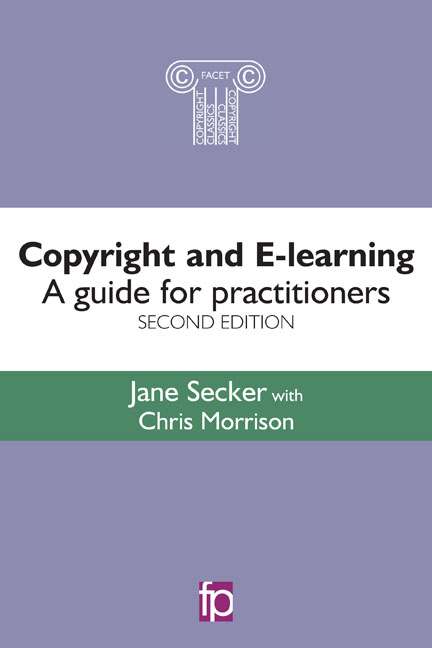Book contents
- Frontmatter
- Contents
- Figures, tables and case studies
- Preface to the second edition
- Introduction
- Abbreviations and acronyms
- Glossary
- 1 E-learning and copyright: background
- 2 Digitizing text-based content for delivery in a VLE
- 3 Using digital media: video, images, sound and software
- 4 Copyright issues and born digital resources
- 5 Copyright in the connected digital environment
- 6 Copyright education and training
- 7 Conclusion
- Further resources
- Index
1 - E-learning and copyright: background
Published online by Cambridge University Press: 08 June 2018
- Frontmatter
- Contents
- Figures, tables and case studies
- Preface to the second edition
- Introduction
- Abbreviations and acronyms
- Glossary
- 1 E-learning and copyright: background
- 2 Digitizing text-based content for delivery in a VLE
- 3 Using digital media: video, images, sound and software
- 4 Copyright issues and born digital resources
- 5 Copyright in the connected digital environment
- 6 Copyright education and training
- 7 Conclusion
- Further resources
- Index
Summary
Introduction
This chapter considers copyright in the digital environment, and its relationship to recent developments in education. It provides an overview of the major differences between copyright laws in several Englishspeaking countries in the world and how they apply to online learning. The focus of this book is on the UK, but it briefly discusses copyright laws in the USA, Australia, Canada and New Zealand. While the book does not replace any legal advice that those developing online learning might need to obtain, it considers how copying can be undertaken for educational purposes. This chapter focuses on various exceptions to copyright law (activities such as copying that can be done without the rights holder's permission) and the impact of copyright issues on face-to-face teaching. The chapter also defines e-learning (or online learning) for the purposes of this book. This definition includes the use of the internet, intranets and secure computer networks such as VLEs, course management systems and other online learning environments. This chapter considers the different effects copyright law has on teaching in the digital environment when compared with the classroom. It also explores new developments in scholarly publishing, including the open access movement and opensource software, along with the development of open licensing schemes such as Creative Commons. This chapter includes the first case study in the book, from Brunel University, where the institution appointed a copyright officer in response to the copyright challenges they were facing.
Recognizing the copyright dilemma
Much of what teachers wish to do in an online learning environment is similar to what they have traditionally done in the classroom. They give students learning activities such as reading, critiquing a work of art or consulting a manuscript source. Students may work individually or in groups. However, online technologies provide huge opportunities to broaden the reach of education by allowing students to participate in learning regardless of their geographic location. Digital technology also allows students to work together asynchronously at a time and place convenient to each learner. Used effectively, e-learning is far more than simply the use of an online document repository, it can be an engaging, online, interactive learning environment. Many of the copyright challenges to e-learning relate to the creation of an online library of resources.
- Type
- Chapter
- Information
- Copyright and E-learninga guide for practitioners, pp. 1 - 46Publisher: FacetPrint publication year: 2016



